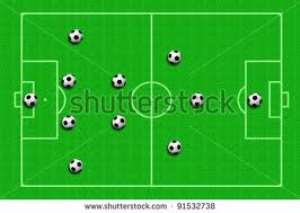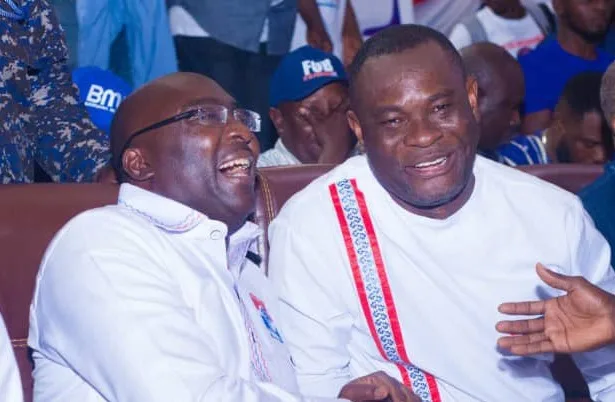
In association football, formation describes how the players in a team are positioned on the pitch. Different formations can be used depending on whether a team wishes to play more attacking or defensive football.
Formations can also be described as the number of players in each area from the defensive line (not including the goalkeeper).For example, the famous 4-4-2 describes the formation as having 4-defenders, 4-midfielders and 2-forwards.The numbering system was not present until the 4-2-4 system was developed in the 1950's.
The choice of formation can be deceptive in analyzing a particular team's style of play. For instance, one team could play 4-4-2 and work defensively, whereas their opposition using the same formation could play much more attacking football. Formations are not static. That is, it can be altered during a game but this requires adaptations of the players to fit into the new system.
Football formations has gone through a lot of metamorphosis from the Pyramid(2-3-5-1) to the Motodo (2-3-2-3),to the WM system (3-2-5 or 3-4-3),the WW(That is,3-5-2 also described as the 3-3-4) to common modern formations such as the 4-4-1-1(Italian 4-4-2),the 3-6-1,the 4-5-1,the 4-3-2-1formation which is known as the 'Christmas Tree', which Terry Venables used throughout England campaign in Euro 96 and the 4-2-3-1 tactical layout which www.sportsmafiagh.com, describes as the modern coach's right hand book.
If readers can recall, almost all the Serbian coaches who have handled the senior national soccer team of Ghana embraced this system to achieve success.
4-2-3-1 a
The 4-2-3-1 is a relatively defensive formation using two holding midfielders not only to screen for defence, but also initiate attacks from midfield.
This formation provides large wing spaces for teams to utilize. Also the distance could be drawn between the central attacking midfield player and the target person (the no 9).
This formation is known to be a defensive formation which is quite flexible, as both the side midfielders and the fullbacks may join the attack usually on the counter.
The lone striker in this formation may be very tall and strong to hold the ball up as his midfielders and fullbacks join him in attack. The striker could also be very fast. In these cases, the opponent's defence will be forced to fall back early thereby leaving space for the offensive central midfielder to operate.
This formation is currently used by Brazil as an alternative to the 4-2-4 formation of late 50's to 1970 with Hulk, Oscar, and Neymar as the creative forwards behind Fred.The use of this formation in this manner is very offensive, creating a 6-man attack and a 6-man defense tactical layout. The front four attackers are composed as wide forwards and playmakers forward in support of a target striker in front.
This formation was used by Fabio Capello to win La Liga with Real Madrid with Beckham and Robinho used as the wing players and Emerson and Diarra as the holding middies. However, because this formation is known to be defensive, Real Madrid resulting played 'ugly' football which seem to have cost Capello's job with the Los Bloncos.
France used this formation in the Euro 2000 tournament final win against Italy with Patrick Vieira and Didier Deschamp as the defensive midfielders and Zinedin Zidane as the head of the creative forwards and Henry Thierry as the lone striker. The French team again used this formation to mesmerize Brazil in the 2006 World Cup.
Rafa Benitez's Liverpool used this 4-2-3-1 formation from time to time with Macherano and Alonso as holding midfielders and Gerrald as attacking midfielder.
For this 4-2-3-1 formation to be very effective, you need a solid defense, deadly counter attack and possessive football. According to our research the 4-2-3-1 formation is the most used tactical formation in the Europe's top five leagues.




 List of 24 ministerial nominees approved by Parliament
List of 24 ministerial nominees approved by Parliament
 You were my inspiration, made me who I am today – Lilian Kumah
You were my inspiration, made me who I am today – Lilian Kumah
 Rainstorm destroys Hohoe E.P. Senior High School building
Rainstorm destroys Hohoe E.P. Senior High School building
 John Kumah strongly supported me to become NPP flagbearer – Bawumia reveals
John Kumah strongly supported me to become NPP flagbearer – Bawumia reveals
 Late John Kumah urged me to run for NPP flagbearer, strongly supported me — Bawu...
Late John Kumah urged me to run for NPP flagbearer, strongly supported me — Bawu...
 Akufo-Addo appoints Joseph Kpemka as Deputy MD of BOST
Akufo-Addo appoints Joseph Kpemka as Deputy MD of BOST
 Ablakwa petitions CHRAJ to investigate sale of SSNIT's hotels to Rock City Hotel
Ablakwa petitions CHRAJ to investigate sale of SSNIT's hotels to Rock City Hotel
 MoF to provide new bailout for defunct Gold Coast Fund investors – Bawumia revea...
MoF to provide new bailout for defunct Gold Coast Fund investors – Bawumia revea...
 OMCs implement price adjustments despite International petroleum price declines
OMCs implement price adjustments despite International petroleum price declines
 Petition to remove Kissi Agyebeng will disrupt operations of OSP – Martin Kpebu
Petition to remove Kissi Agyebeng will disrupt operations of OSP – Martin Kpebu
